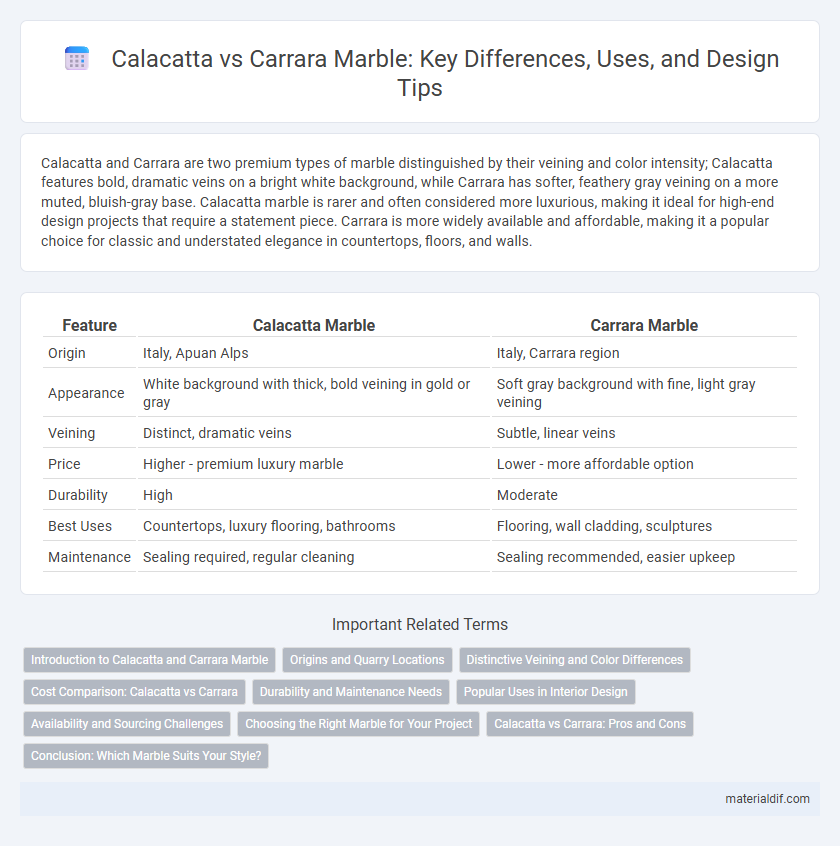Calacatta and Carrara are two premium types of marble distinguished by their veining and color intensity; Calacatta features bold, dramatic veins on a bright white background, while Carrara has softer, feathery gray veining on a more muted, bluish-gray base. Calacatta marble is rarer and often considered more luxurious, making it ideal for high-end design projects that require a statement piece. Carrara is more widely available and affordable, making it a popular choice for classic and understated elegance in countertops, floors, and walls.
Table of Comparison
| Feature | Calacatta Marble | Carrara Marble |
|---|---|---|
| Origin | Italy, Apuan Alps | Italy, Carrara region |
| Appearance | White background with thick, bold veining in gold or gray | Soft gray background with fine, light gray veining |
| Veining | Distinct, dramatic veins | Subtle, linear veins |
| Price | Higher - premium luxury marble | Lower - more affordable option |
| Durability | High | Moderate |
| Best Uses | Countertops, luxury flooring, bathrooms | Flooring, wall cladding, sculptures |
| Maintenance | Sealing required, regular cleaning | Sealing recommended, easier upkeep |
Introduction to Calacatta and Carrara Marble
Calacatta and Carrara marble are renowned Italian stones prized for their unique veining and luxurious appearance. Calacatta marble features bold, dramatic veining on a bright white background, often used in high-end interior design for a striking, elegant look. Carrara marble, characterized by its softer gray veining on a light gray or white base, offers a classic, understated aesthetic commonly found in sculptures and architectural elements.
Origins and Quarry Locations
Calacatta marble originates primarily from the Carrara region in Tuscany, Italy, specifically from quarries near the town of Carrara, renowned for its rare and luxurious white stone with bold veining. Carrara marble also comes from the same geographic area but is more abundant and features softer gray veining with a whiter or bluish-gray background. Both marbles share Italian origins but differ significantly in quarry yield and vein intensity, influencing their desirability and pricing in architectural and design applications.
Distinctive Veining and Color Differences
Calacatta marble is characterized by its bold, dramatic veining with wide, irregular gold and gray streaks against a bright white background, making it highly sought after for luxury designs. In contrast, Carrara marble features softer, more subtle veining with fine gray lines on a cooler, bluish-gray or white base, offering a more understated and classical appearance. These distinctive veining and color differences between Calacatta and Carrara marble influence their applications in architecture and interior design, with Calacatta favored for statement pieces and Carrara preferred for timeless elegance.
Cost Comparison: Calacatta vs Carrara
Calacatta marble is generally more expensive than Carrara due to its rarity and distinctive bold veining, with prices often ranging from $180 to $300 per square foot compared to Carrara's $75 to $150 per square foot. The higher cost of Calacatta also reflects its limited availability and premium aesthetic appeal in luxury applications. Homeowners and designers often weigh the budget impact when choosing between the more affordable Carrara and the prestigious Calacatta marble options.
Durability and Maintenance Needs
Calacatta marble exhibits exceptional durability due to its denser structure, making it more resistant to scratches and etching compared to Carrara. Carrara marble requires more frequent sealing and careful maintenance to prevent staining and wear, given its softer composition. Both stones demand proper care, but Calacatta's lower porosity and hardness reduce long-term maintenance efforts significantly.
Popular Uses in Interior Design
Calacatta marble is prized for its dramatic, bold veining and is commonly used in high-end kitchen countertops, statement bathroom vanities, and luxurious tabletops to create a striking focal point. Carrara marble, featuring softer, more subtle gray veining, is often selected for flooring, backsplashes, and fireplace surrounds to achieve a timeless, elegant look. Both marbles are favored in interior design for their durability and classic aesthetic, but Calacatta's rarity makes it a premium choice for luxury applications.
Availability and Sourcing Challenges
Calacatta marble is rarer and primarily quarried in limited regions of Carrara, Italy, making its availability more restricted compared to Carrara marble, which is more abundant and widely sourced from the same area. The sourcing challenges for Calacatta involve higher costs and longer lead times due to its limited extraction zones and premium quality standards. Conversely, Carrara marble's broader availability supports easier procurement and more competitive pricing for construction and design projects.
Choosing the Right Marble for Your Project
Calacatta marble features bold, thick veining with a bright white background, making it ideal for luxurious, statement spaces, whereas Carrara marble offers a softer, grayish tone with delicate veining suited for traditional and contemporary designs. Selecting the right marble depends on your project's style, budget, and desired visual impact, with Calacatta generally commanding a higher price due to its rarity and dramatic appearance. Consider durability, maintenance, and lighting conditions to ensure the marble complements both aesthetic and functional requirements.
Calacatta vs Carrara: Pros and Cons
Calacatta marble is prized for its bold, dramatic veining and bright white background, making it a luxurious choice but often comes with a higher price and less availability compared to Carrara. Carrara marble features a softer, more subtle gray veining with a cooler tone, offering greater affordability and widespread use, yet it may stain or scratch more easily than Calacatta. While Calacatta suits high-end, visually striking installations, Carrara is preferred for versatile, cost-effective designs balancing elegance and durability.
Conclusion: Which Marble Suits Your Style?
Calacatta marble features bold, dramatic veining and a luxurious appearance, making it ideal for statement pieces and high-end interiors. Carrara marble offers a softer, more subtle veining pattern suited for timeless, classic designs and budget-friendly projects. Choose Calacatta for a sophisticated, eye-catching look, while Carrara fits well with understated elegance and versatile applications.
Calacatta vs Carrara Infographic

 materialdif.com
materialdif.com